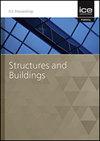抛掷台阶对钢筋混凝土拱桥地震反应的影响
IF 1.4
4区 工程技术
Q3 CONSTRUCTION & BUILDING TECHNOLOGY
Proceedings of the Institution of Civil Engineers-Structures and Buildings
Pub Date : 2023-09-01
DOI:10.1680/jstbu.23.00040
引用次数: 0
摘要
在世界各地的近断裂带已经建造了许多拱桥,它们可能受到冲击步进的影响,冲击步进是由地震频率范围内的长周期脉冲引起的永久性地面位移。本文研究了抛跃台阶对中短跨钢筋混凝土上承式拱桥的影响。建立了伊朗3座跨度分别为23,35和60米的既有钢筋混凝土拱桥的三维非线性模型。这些结构在纵向和横向上经历了7次近断层地震,其中一次包含了跳跃阶跃脉冲,另一次去掉了脉冲。结果表明,抛动阶跃对所研究的地震反应指标有显著影响,但可能增加或减少地震需求。有甩步时的最大曲率与无甩步时的最大曲率在0.54 ~ 2.06之间。纵向脱座对甩步最敏感,在某些情况下增加了200%以上。甩甩阶跃脉冲的影响与结构基本振型周期与甩甩阶跃脉冲周期的比值有关。本文章由计算机程序翻译,如有差异,请以英文原文为准。
Effects of fling step on the seismic response of reinforced concrete arch bridges
Many arch bridges have been built in near-fault regions around the world and may be affected by fling step, which is the permanent ground displacement caused by the long-period pulse within the frequency content of the earthquake. This study investigates the effect of fling step on reinforced concrete deck-type arch bridges with short to medium spans. Three-dimensional nonlinear models of three existing reinforced concrete arch bridges in Iran, with span lengths of 23, 35, and 60 meters were developed. The structures were subjected to seven near-fault earthquakes in longitudinal and transverse directions, once with the fling step pulse included and once with the pulse removed. The results showed that fling step has a noticeable effect on the seismic response indicators investigated but may increase or decrease the seismic demand. The maximum curvature in the presence of fling step to that without fling step ranged between 0.54 and 2.06. Unseating in the longitudinal direction was the most sensitive to the fling step, which showed more than 200-percent increase in some cases. The effects of the fling step were correlated with the ratio of the period of the fundamental mode of vibration of the structure to that of the fling step pulse.
求助全文
通过发布文献求助,成功后即可免费获取论文全文。
去求助
来源期刊
CiteScore
3.40
自引率
6.20%
发文量
61
审稿时长
12 months
期刊介绍:
Structures and Buildings publishes peer-reviewed papers on the design and construction of civil engineering structures and the applied research associated with such activities. Topics include the design, strength, durability and behaviour of structural components and systems.
Topics covered: energy conservation, people movement within and around buildings, strength and durability of steel and concrete structural components, and the behaviour of building and bridge components and systems

 求助内容:
求助内容: 应助结果提醒方式:
应助结果提醒方式:


